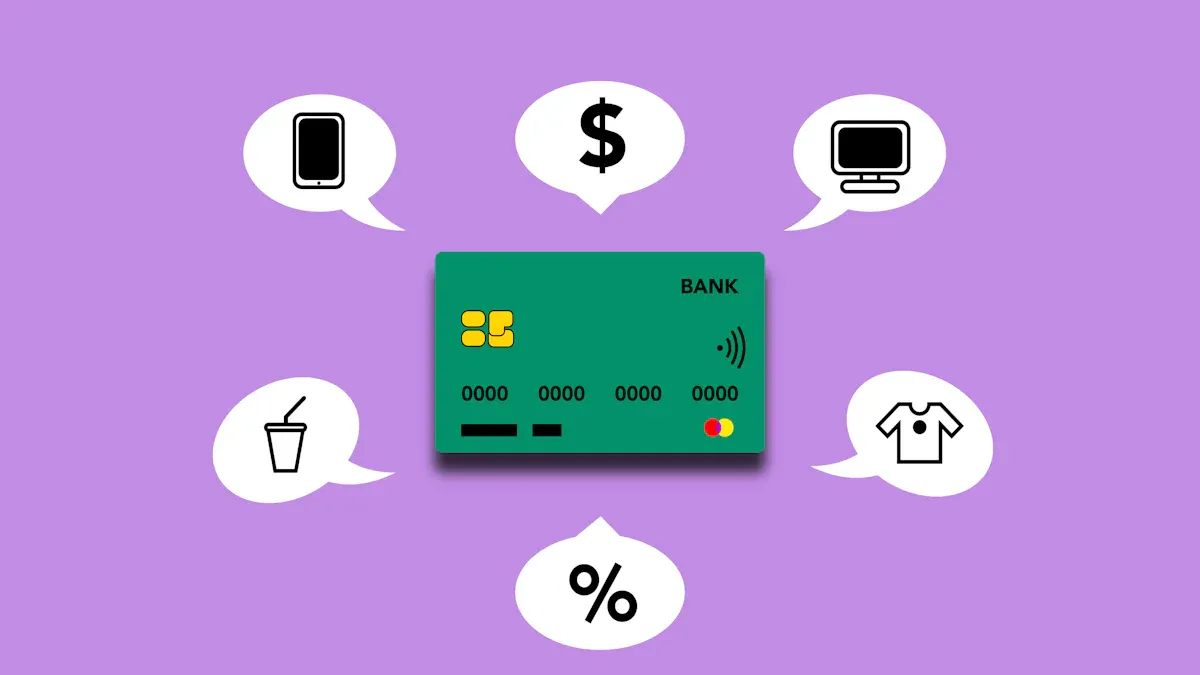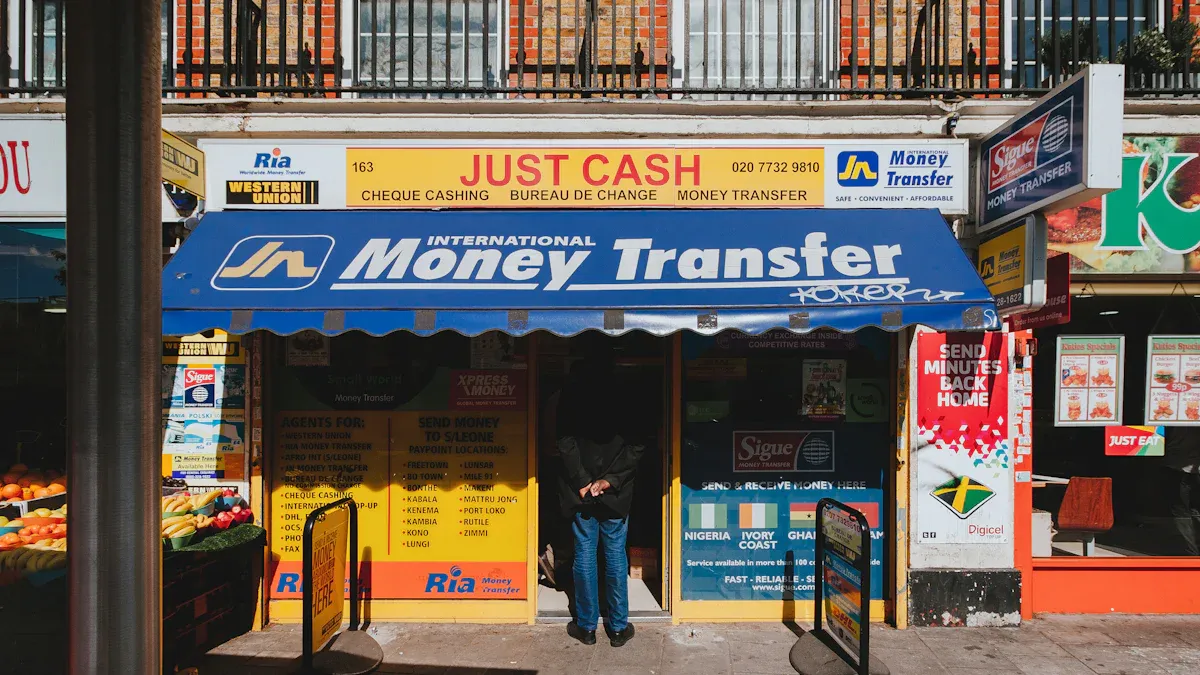- EasyCard
- Trade
- Help
- Announcement
- Academy
- SWIFT Code
- Iban Number
- Referral
- Customer Service
- Blog
- Creator
How to Remit Money from the US to South Korea? A Detailed Analysis of Remittance Channels, Fees, and Restrictions

Image Source: pexels
Do you want to send money from the US to South Korea? You need to consider remittance methods, fees, delivery speed, and exchange rates. You also need to understand compliance requirements and risk prevention. Choosing the right channel can help you save money and protect your funds. This article will help you make informed decisions when sending money from the US, avoiding common pitfalls.
Key Points
- Choosing the right remittance method can save fees and improve delivery speed. Digital platforms like Remitly and Paysend are typically more convenient, suitable for small and frequent transfers.
- Bank wire transfers are ideal for large amounts, offering high security, but fees are expensive, and delivery takes longer, usually 1-3 business days.
- Remittance fees vary by channel, with digital platforms generally having lower fees, some even waiving fees for large transfers.
- Ensure the recipient’s information is accurate to avoid delays or failed transfers. Using legitimate channels reduces risks.
- Comply with legal requirements, understand amount limits, and file tax reports to ensure compliance and avoid potential legal issues.
US Remittance Methods

Image Source: unsplash
When choosing a method to send money from the US to South Korea, you can consider the following mainstream channels:
| Remittance Method | Percentage |
|---|---|
| Pure Digital Platforms | 59% |
| Digital Methods Requiring Physical Locations | 41% |
The global digital remittance market is growing rapidly. More and more people are choosing digital platforms for US remittances. You can operate via mobile phone or computer, which is convenient and fast.
Bank Wire Transfer
You can send money directly from a US bank to a South Korean bank account. Bank wire transfers are suitable for large amounts or scenarios requiring high security. The advantage is high security, ideal for formal fund transfers. The downside is high fees, typically between 20-50 USD, and delivery may take 1-3 business days. Some banks also charge intermediary fees.
Remittance Platforms
You can choose international remittance platforms like Remitly, Xoom, Paysend, or Wise. These platforms support online operations and are simple, suitable for daily expenses, tuition, or family support. The advantages are transparent fees, with some platforms like Paysend starting at 1.99 USD, and fast delivery, some arriving in minutes. The downside is that some platforms have limits on large transfers.
Digital Wallets
Digital wallets like PayPal also support remittances from the US to South Korea. You only need both parties to have accounts. They are suitable for small, frequent personal transfers. The advantages are flexible operations and fast delivery. The downsides are less favorable exchange rates compared to banks or professional platforms, higher fees, and withdrawal restrictions for some services.
Cash Services
Cash services like Western Union are suitable when you need the recipient to collect cash directly. You can send money at a US service point, and the recipient withdraws cash at a South Korean location. The advantage is that no bank account is required, ideal for emergencies. The downsides are high fees, unstable exchange rates, and amount restrictions.
Tip: If you prioritize speed and convenience, consider digital platforms first. In the US remittance market, 59% of users choose purely digital methods, showing a clear digital trend.
Remittance Methods Breakdown
Operation Process
You can complete a remittance from the US to South Korea through various methods. The steps vary slightly by platform, but the overall process is straightforward. Here is the standard process for common digital platforms:
- Download the relevant app and register an account. You need to provide a US driver’s license, passport, or other government-issued ID.
- Select South Korea as the remittance destination.
- Enter the amount you wish to send.
- Choose the recipient’s bank, such as Shinhan Bank, KEB Hana Bank, or Kookmin Bank.
- Fill in the recipient’s details, including bank account number, address, and contact phone number.
- Select a payment method, such as a bank account, debit card, or credit card.
- Confirm the information and complete the payment.
If you use Xoom, you can log in with a PayPal account, enter the amount and recipient information, select a payment method, and complete the transaction. For bank wire transfers, you need to visit a bank branch or use online banking, provide the recipient’s bank details and amount, and the bank will process the remittance.
Tip: Ensure the recipient’s information is accurate during the process to avoid delays or failures due to errors.
Fee Structure
Fees for sending money from the US to South Korea vary by channel. You need to consider transfer fees, exchange rate margins, and possible intermediary fees. Here’s a fee comparison for major platforms and banks:
| Service | Fee (USD) |
|---|---|
| Remitly | Free for transfers over $1,000; $3.99 for less than $1,000 |
| Xoom | $4.99 for bank account transfers; $15.00 for debit/credit card |
| Paysend | Starting at $1.99 |
| Wise | Varies by payment method and amount, starting at ~$2.49 |
| Traditional Banks | $25 - $50 |
When choosing a platform, note that some, like Remitly, waive fees for transfers over 1,000 USD, Paysend has low starting fees, and Xoom charges more for debit or credit card payments. Bank wire transfers have the highest fees, suitable for large amounts and high-security needs.
Delivery Time
Delivery speed is a key factor when choosing a US remittance method. Different platforms and banks have varying delivery times:
| Provider | Delivery Time | Supported Banks |
|---|---|---|
| Wise | 3-7 days / as fast as 9 hours | Shinhan Bank, KEB Hana Bank, Kookmin Bank, etc. |
| Remitly | Minutes to 1 day | Major South Korean banks |
| Xoom | 1-2 days | Woori Bank: 5-24 hours; others ~3 days |
| Paysend | Usually same day | Supports multiple South Korean banks |
| Traditional Banks | 1-3 business days | All major South Korean banks |
If you prioritize speed, consider digital platforms like Remitly or Paysend. Bank wire transfers are slower but offer high security, ideal for large amounts.
Pros and Cons
When choosing a US remittance method, you need to balance security, convenience, fees, and delivery speed. Here’s an analysis of the pros and cons:
- Bank Wire Transfer: High security, suitable for large remittances. High fees, slow delivery, and cumbersome process.
- Remittance Platforms (Remitly, Xoom, Paysend, Wise): Convenient, low fees, fast delivery. Suitable for daily expenses, tuition, and family support. Some platforms limit large transfers.
- Digital Wallets (PayPal): Flexible, suitable for small, frequent transfers. High fees, less favorable exchange rates, and withdrawal restrictions.
- Cash Services (Western Union): No bank account required, ideal for emergencies. High fees, amount limits, and fluctuating exchange rates.
You can choose the most suitable channel based on your remittance amount, frequency, and delivery needs. The US remittance market shows a strong digital trend, with digital platforms being more popular, but bank wire transfers remain an option for large or special needs.
US Remittance Fee Comparison

Image Source: unsplash
Transfer Fees
When choosing a US remittance channel, you should first focus on transfer fees. Fee structures vary significantly across platforms and banks. Digital platforms like Remitly, Paysend, and Wise typically charge lower fixed fees. For example, Paysend starts at 1.99 USD, and Wise starts at around 2.49 USD. Remitly waives fees for remittances over 1,000 USD. Traditional bank wire transfers have higher fees, typically 25-50 USD. You also need to watch for intermediary bank fees, which can add 15-50 USD per transaction. Currency conversion fees also affect the total cost, sometimes charged by intermediary or receiving banks.
Tip: Before sending money, inquire about all possible fees to avoid reduced final amounts due to hidden costs.
Exchange Rates
Exchange rates directly determine the amount of KRW the recipient receives. The exchange rate varies by platform. The table below shows rates and final amounts for major platforms:
| Provider | Exchange Rate | Transfer Fee | Recipient Receives for Sending 1,000 USD |
|---|---|---|---|
| Wise | 1,393.40 | 13.83 USD | 1,374,129 KRW - 9,468 KRW |
| Other | 1,383.60 | 0.00 USD | 1,383,597 KRW |
| Other | 1,382.88 | 2.49 USD | 1,379,436 KRW - 4,161 KRW |
You can see that higher exchange rates mean more KRW for the recipient. Banks and remittance services often add a margin to the market rate, affecting your remittance outcome. Compare platforms’ rates and fees to choose the best option.
- Exchange rate margins result in rates lower than the market rate.
- Rate differences and fees together impact the final amount received.
Delivery Speed
Delivery speed is another key factor when choosing a US remittance method. Digital platforms like Remitly, Paysend, and Wise can deliver on the same day or even in minutes. Traditional bank wire transfers take 1-5 business days. The table below compares average delivery times:
| Transfer Method | Average Time |
|---|---|
| International Wire Transfer | One to five business days |
| Digital Currency Transfer | Possibly within minutes |
If you need fast delivery, prioritize digital platforms. Digital currency transfers are the fastest, ideal for urgent needs.
- Digital platforms are fast, suitable for daily and urgent remittances.
- Bank wire transfers are secure but slower, ideal for large amounts.
When choosing a US remittance channel, consider fees, exchange rates, and delivery speed together, while watching for hidden costs to maximize the recipient’s final amount.
Compliance and Restrictions
Legal Requirements
When conducting cross-border remittances, you must comply with US and South Korean legal regulations. Financial institutions conduct due diligence on your identity to ensure transaction safety. The Korea Financial Intelligence Unit (KoFIU) requires institutions to submit reports for suspicious transactions, and cash transactions exceeding KRW 10 million must also be reported. The table below summarizes key legal requirements:
| Legal Requirement | Description |
|---|---|
| Suspicious Transaction Report (STR) | Financial institutions and casinos must report to KoFIU if funds are suspected to be proceeds of crime. |
| Currency Transaction Report (CTR) | Cash transactions exceeding KRW 10 million must be reported. |
| Customer Due Diligence (CDD) | Institutions must verify customer identity and assess risks. |
In the US, individuals can send up to 5,000 USD annually without additional authorization, but transactions cannot go through sanctioned institutions. You need to prepare valid ID and recipient information to ensure compliance.
Amount Limits
When remitting, be mindful of amount limits and tax reporting. In the US, single or annual remittances exceeding 10,000 USD must be reported to the IRS. If you have accounts in South Korea with a total exceeding 10,000 USD, you must file a Foreign Bank Account Report (FBAR). Key points include:
- US taxpayers must report global income, including earnings in South Korea.
- International transfers over 10,000 USD must be reported to the IRS.
- Banks must comply with the Bank Secrecy Act, reporting large international remittances.
- South Korea has reporting thresholds for cash transactions, requiring compliance.
Risk Prevention
During the remittance process, beware of risks like money laundering, fraud, and account freezes. The Korea Financial Intelligence Unit focuses on combating money laundering and terrorist financing. There have been historical cases of penalties for illegal fund transfers. Underground banking systems and illegal remittance activities increase risks. You can take the following measures to reduce risks:
- Choose reputable international remittance providers to ensure fund safety.
- Understand all fees and exchange rates before transferring to avoid hidden costs.
- Verify recipient information to ensure accuracy.
- Monitor transfer status to track fund movement.
- Use encryption technology and secure servers to protect financial information.
- Check online reviews and forums to assess provider customer satisfaction.
If you plan your remittance in advance and use independent exchange rate tools to compare platforms, you can achieve better transaction outcomes.
Selection Tips
Use Cases
When choosing a channel for sending money from the US to South Korea, base your decision on the remittance amount, frequency, and delivery speed. Different platforms suit different needs. The table below helps you compare quickly:
| User Type | Recommended Channel | Main Advantages |
|---|---|---|
| Large Remittances | Bank Wire Transfer | High security, suitable for formal fund transfers |
| Small, Frequent Remittances | Digital Platforms (Wise, Paysend, Remitly) | Low fees, fast delivery |
| Urgent Cash Needs | Cash Services (Western Union) | No bank account required, ideal for emergencies |
When choosing a platform, focus on these factors:
- Transfer Fees: Traditional banks and some platforms charge high fixed or percentage-based fees. Prioritize platforms with low fees.
- Exchange Rates: Many services inflate rates, reducing the recipient’s amount. Choose platforms close to mid-market rates.
- Intermediary Fees: Transfers through multiple banks may incur hidden fees. Inquire about all fee details in advance.
- Delivery Speed: For fast delivery, choose digital platforms.
- Security: Verify if the platform uses encryption to ensure fund and information safety.
Before sending money, compare fees and exchange rates across platforms to maximize the recipient’s final amount.
Risk Warnings
During the remittance process, beware of scams and pitfalls. Common risks include fake check scams, confirmation code requests, and international remittance fraud. You can take these measures to protect your funds:
- Do not send money to anyone who contacts you unsolicited, no matter how credible their story seems.
- Anyone claiming to transfer real funds to you is a scammer.
- If someone asks you to pay via wire transfer, gift card, or cryptocurrency, it’s a scam.
- Scammers may request confirmation codes or Money Transfer Control Numbers (MTCN), but you don’t need these to withdraw funds.
- Report suspicious activity to the US Federal Trade Commission (FTC) to help stop scammers.
South Korea has recently tightened regulations on stablecoins and cross-border payments, and platforms may adjust their policies. When choosing a channel, prioritize licensed, legitimate platforms and avoid unclear channels to ensure fund safety and compliance.
When choosing a method to send money from the US to South Korea, focus on fees, delivery speed, security, and compliance. Different channels have their pros and cons: digital platforms offer low fees and fast delivery, while bank wire transfers provide high security. Choose flexibly based on your needs, prioritizing legitimate channels. Recent policy and platform updates suggest staying informed:
| Update | Details |
|---|---|
| Remittance Policy | Foreign investors can remit upon approval of original investments. Banks control the approval process for remittances. |
| Fund Repatriation | Businesses must provide audited financial statements and stock valuation reports to support remittances. |
| Regulatory Revisions | On November 13, 2023, the Ministry of Economy and Finance submitted amendments to FETA, expected to take effect in July 2024. |
You can compare options, make informed decisions, and ensure fund safety.
FAQ
What documents are needed to send money from the US to South Korea?
You need to provide a valid ID, recipient’s bank information, and remittance amount. Some platforms may require you to upload a passport or driver’s license photo.
How long does it take for a remittance to arrive?
When using digital platforms, funds typically arrive the same day. Bank wire transfers generally take 1-3 business days. Delivery times vary by platform and bank.
Are there limits on remittance amounts?
For remittances exceeding 10,000 USD per transaction, banks report to the US IRS. Some platforms have caps on single or annual remittances, so check in advance.
What to do if a remittance fails?
First, verify the recipient’s information for accuracy, then contact the remittance platform’s customer service. For bank wire transfer issues, consult bank staff directly.
How are remittance fees calculated?
With digital platforms, fees are usually fixed, such as 1.99 USD or 4.99 USD. Bank wire transfers have higher fees, around 25-50 USD. Compare fees across channels in advance.
Remitting to Canada involves bank wire fees of $15-80, 1-3 business day delays, and $10,000 USD reporting thresholds, especially amid 2025’s projected $80+ trillion remittance market, where traditional channels’ markups and compliance reviews erode received amounts. For a cheaper, faster alternative, explore BiyaPay. BiyaPay’s remittance fees start at 0.5%, enabling seamless fiat-to-crypto conversions across most countries and regions, with quick registration and same-day delivery for maximum recipient value.
BiyaPay lets you trade stocks in US and Hong Kong markets on one platform, no overseas account needed, with zero fees on contract orders. Sign up now and use the real-time exchange rate tool to monitor rates, timing your transfers for a secure, cost-effective global finance experience.
*This article is provided for general information purposes and does not constitute legal, tax or other professional advice from BiyaPay or its subsidiaries and its affiliates, and it is not intended as a substitute for obtaining advice from a financial advisor or any other professional.
We make no representations, warranties or warranties, express or implied, as to the accuracy, completeness or timeliness of the contents of this publication.




Contact Us
Company and Team
BiyaPay Products
Customer Services
is a broker-dealer registered with the U.S. Securities and Exchange Commission (SEC) (No.: 802-127417), member of the Financial Industry Regulatory Authority (FINRA) (CRD: 325027), member of the Securities Investor Protection Corporation (SIPC), and regulated by FINRA and SEC.
registered with the US Financial Crimes Enforcement Network (FinCEN), as a Money Services Business (MSB), registration number: 31000218637349, and regulated by FinCEN.
registered as Financial Service Provider (FSP number: FSP1007221) in New Zealand, and is a member of the Financial Dispute Resolution Scheme, a New Zealand independent dispute resolution service provider.



















